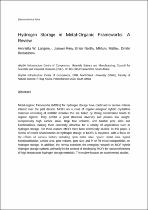JavaScript is disabled for your browser. Some features of this site may not work without it.
- ResearchSpace
- →
- Research Publications/Outputs
- →
- Journal Articles
- →
- View Item
| dc.contributor.author |
Langmi, Henrietta W

|
|
| dc.contributor.author |
Ren, Jianwei

|
|
| dc.contributor.author |
North, Brian C

|
|
| dc.contributor.author |
Mathe, Mahlanyane K

|
|
| dc.contributor.author |
Bessarabov, D

|
|
| dc.date.accessioned | 2014-08-25T10:13:31Z | |
| dc.date.available | 2014-08-25T10:13:31Z | |
| dc.date.issued | 2014-05 | |
| dc.identifier.citation | Langmi, H.W, Ren, J, North, B, Mathe, M and Bessarabov, D. 2014. Hydrogen storage in metal-organic frameworks: A review. Electrochimica Acta, pp 368-392 | en_US |
| dc.identifier.issn | 0013-4686 | |
| dc.identifier.uri | http://pubs.rsc.org/en/content/articlepdf/2009/cs/b802256a | |
| dc.identifier.uri | http://hdl.handle.net/10204/7624 | |
| dc.identifier.uri | https://www.sciencedirect.com/science/article/pii/S0013468613021622 | |
| dc.identifier.uri | https://doi.org/10.1016/j.electacta.2013.10.190 | |
| dc.description | Copyright: 2014 Elsevier. This is an ABSTRACT ONLY. The definitive version is published in Electrochimica Acta, vol 128: pp 368-392 | en_US |
| dc.description.abstract | Metal-organic frameworks (MOFs) for hydrogen storage have continued to receive intense interest over the past decade. MOFs are a class of organic-inorganic hybrid crystalline materials consisting of metallic moieties that are linked by strong coordination bonds to organic ligands. They exhibit a great structural diversity and possess low weight, exceptionally high surface areas, large free volumes, and tunable pore sizes and functionalities, making them extremely attractive for a variety of applications such as hydrogen storage. For these reasons MOFs have been extensively studied. In this paper, a review of recent developments on hydrogen storage in MOFs is presented, with a focus on the effects of various factors including open metal sites, ‘guest’ metal ions, ligand functionalization, surface area, pore volume, pore size, and Pt or Pd metal nanoparticles, on hydrogen storage. In addition, the review examines the emerging research on MOF hybrid hydrogen storage systems, primarily in the context of employing MOFs for nanoconfinement of high temperature hydrogen storage materials. The review focuses on experimental studies. | en_US |
| dc.language.iso | en | en_US |
| dc.publisher | Elsevier | en_US |
| dc.relation.ispartofseries | Workflow;13261 | |
| dc.subject | Metal-organic frameworks | en_US |
| dc.subject | MOFs | en_US |
| dc.subject | Hydrogen storage | en_US |
| dc.subject | Hybrid hydrogen storage material | en_US |
| dc.title | Hydrogen storage in metal-organic frameworks: A review | en_US |
| dc.type | Article | en_US |
| dc.identifier.apacitation | Langmi, H. W., Ren, J., North, B. C., Mathe, M. K., & Bessarabov, D. (2014). Hydrogen storage in metal-organic frameworks: A review. http://hdl.handle.net/10204/7624 | en_ZA |
| dc.identifier.chicagocitation | Langmi, Henrietta W, Jianwei Ren, Brian C North, Mahlanyane K Mathe, and D Bessarabov "Hydrogen storage in metal-organic frameworks: A review." (2014) http://hdl.handle.net/10204/7624 | en_ZA |
| dc.identifier.vancouvercitation | Langmi HW, Ren J, North BC, Mathe MK, Bessarabov D. Hydrogen storage in metal-organic frameworks: A review. 2014; http://hdl.handle.net/10204/7624. | en_ZA |
| dc.identifier.ris | TY - Article AU - Langmi, Henrietta W AU - Ren, Jianwei AU - North, Brian C AU - Mathe, Mahlanyane K AU - Bessarabov, D AB - Metal-organic frameworks (MOFs) for hydrogen storage have continued to receive intense interest over the past decade. MOFs are a class of organic-inorganic hybrid crystalline materials consisting of metallic moieties that are linked by strong coordination bonds to organic ligands. They exhibit a great structural diversity and possess low weight, exceptionally high surface areas, large free volumes, and tunable pore sizes and functionalities, making them extremely attractive for a variety of applications such as hydrogen storage. For these reasons MOFs have been extensively studied. In this paper, a review of recent developments on hydrogen storage in MOFs is presented, with a focus on the effects of various factors including open metal sites, ‘guest’ metal ions, ligand functionalization, surface area, pore volume, pore size, and Pt or Pd metal nanoparticles, on hydrogen storage. In addition, the review examines the emerging research on MOF hybrid hydrogen storage systems, primarily in the context of employing MOFs for nanoconfinement of high temperature hydrogen storage materials. The review focuses on experimental studies. DA - 2014-05 DB - ResearchSpace DP - CSIR KW - Metal-organic frameworks KW - MOFs KW - Hydrogen storage KW - Hybrid hydrogen storage material LK - https://researchspace.csir.co.za PY - 2014 SM - 0013-4686 T1 - Hydrogen storage in metal-organic frameworks: A review TI - Hydrogen storage in metal-organic frameworks: A review UR - http://hdl.handle.net/10204/7624 ER - | en_ZA |






